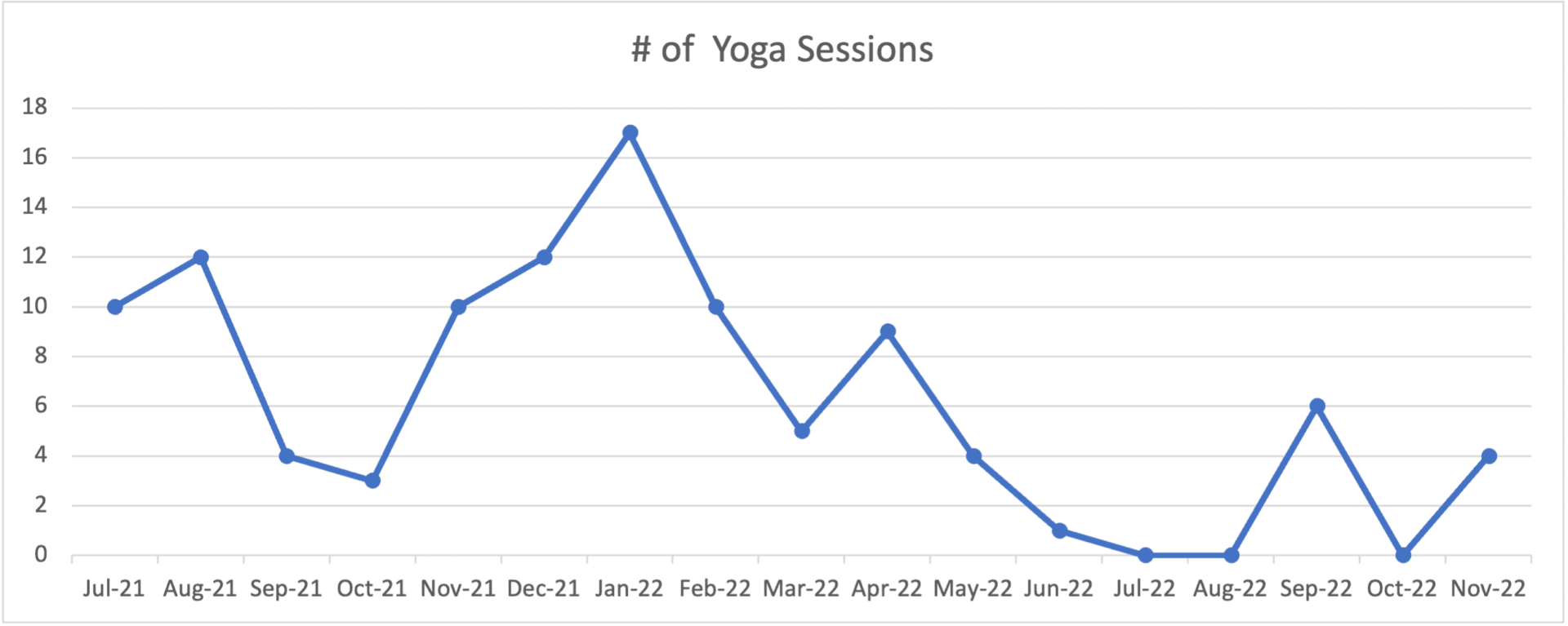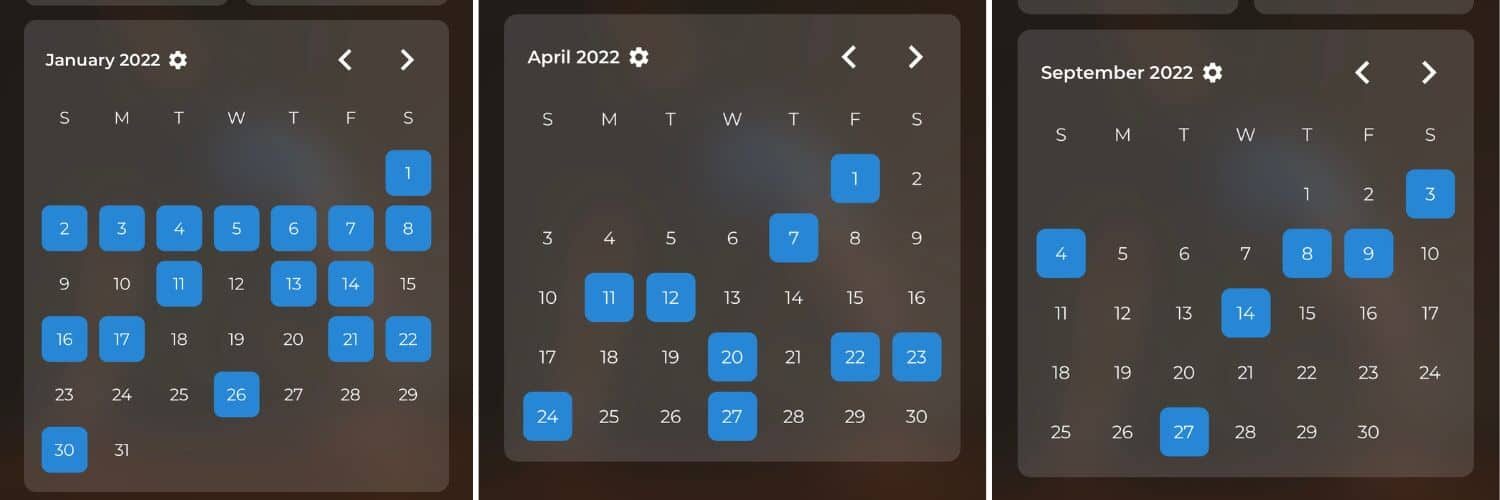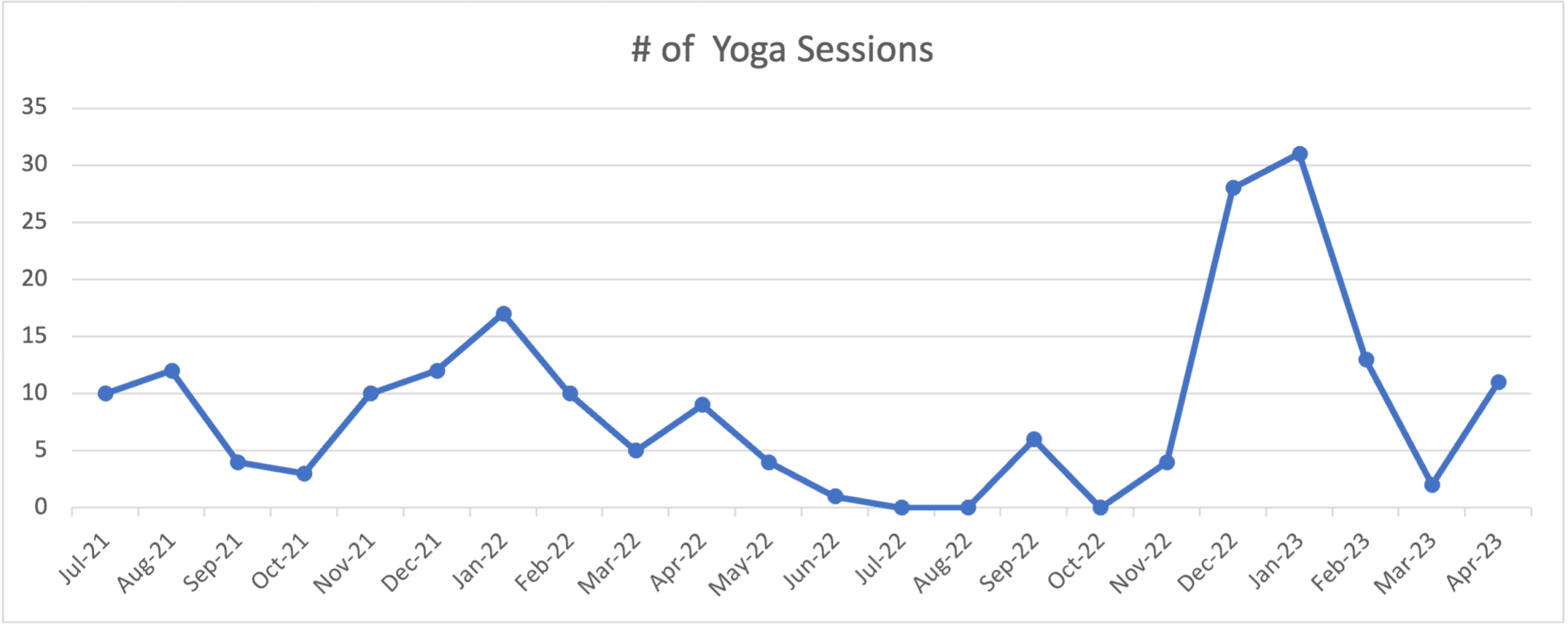I've often been in a position to coach and counsel leaders who find it difficult to put the daily in what some call Lean Daily Management. I've been trying to fix my lower back by practicing yoga daily. There are some striking parallels that I'll explore in this post.
Putting the Daily in Lean Daily Management
If managers have been trained in Lean management practices, like leading huddle meetings and facilitating continuous improvement (or “kaizen“), they might struggle with their motivation to do so. They might lack competence or confidence (or both).
In the language of “Motivational Interviewing,” they have reasons TO, for example, hold their daily huddles (even if that reason was just “I was told I had to”). They also have reasons NOT to do them (such as a lack of time, a lack of belief in the system, and a lack of confidence in their ability to lead this way).
As I learned from the practice of M.I., when somebody is in this state of “ambivalence” to change (which is not “resistance”), it's helpful to ask the person to state their reasons TO do something. Doing so, especially saying it out loud, strengthens their commitment to take action. Asking them to talk about their barriers has the opposite (and negative) effect.
I once asked a nurse manager who was struggling with this to state her top three reasons why she WANTED to do the huddles. Saying her reasons out loud helped her feel more confident about figuring out how to prioritize this (including how to make time). I was coaching her. I couldn't tell her she had to do the daily huddles… daily.
The Journey of My Lower Back: Herniated Disk
I approach age 50 in October, and I'm not alone in having lower back issues at this age.
The year 2020 started with me being laid up in bed with excruciating pain. There was no New Year's Eve party for me that year. I could barely get out of bed or walk. I ended up in the emergency room the next morning. I don't know what caused it, but I had a badly herniated disk pressing on a nerve, as confirmed later by the imaging. I had shooting pain and numbness down my left leg.
By the time I got scheduled with an orthopedic spine specialist, he was convinced that I needed surgery. Not only that but if I didn't have the surgery, he was convinced I would forever have numbness in that leg and foot. I realize we shouldn't rush into back surgery, but it was so debilitating it seemed surgery was necessary.
The surgeon said I'd have to stay home and not travel by air for six weeks for my back to heal after surgery. This surgeon was near our secondary home in the Dallas area. I figured that if I couldn't travel for six weeks, I'd have the surgery and stay home at our then-primary home in Orlando.
I went to the Orlando orthopedic, assuming surgery was the only countermeasure. As it turns out, this surgeon was younger and had more recent training. He even pointed me to journal articles that showed that outcomes were actually better when NOT having surgery. Whoa. Mind blown.
Mistake Avoided: It might have been a mistake to rush into surgery without getting a second opinion. Again, I didn't get that second opinion because I doubted the Dallas-area surgeon. Lesson learned. Maybe my insurance would have required a second opinion.
Then Covid happened, so surgery wouldn't have happened for a while anyway.
Sure enough, the Orlando surgeon was correct. As he predicted, the numbness gradually “drained” from my leg. Months later, the numbness was only in my ankle… then just my foot… then just my toes.
The second surgeon said something like, “The body has mechanisms for identifying and ‘cleaning up' that disk material that was in places it shouldn't be. Later imaging in April 2021 showed that the herniated disk and the extrusion out from the disks was pretty much completely gone. The root cause of the problem was cleared up, and the symptoms were gone as well.
I'm glad we implemented the non-surgical countermeasure.
Exercise Challenges with Covid
We moved to Los Angeles in late April 2020. The gym in our large condo building was shut down for at least 18 months (by my recollection) because of stringent Los Angeles County restrictions.
As I got full mobility back, I was able to go for brisk walks as my exercise. It got me out of my extremely work-from-home Covid situation, got me fresh air, and introduced me to the local California sea lions!
The walks, sometimes 60- or 90-minutes long, were better than being sedentary. But I wasn't really doing any exercise that got my heart rate up, like an elliptical machine. Trying to even do pushups or other bodyweight exercises either felt uncomfortable, or I feared making my back worse.
I gained a little bit of pandemic weight. I could make better healthy eating choices at home and not on the road. I had time to go for walks. But the lack of weight training, vigorous cardio, and more at-home Covid cocktails… I gained about ten pounds (again, it could have been worse).
A New Back Problem With Different Causes
By the middle of 2021, a new lower back problem had developed. I could sit down, get up, and move around just fine. But when I lay down in bed or deeply into a couch, I had a lot of trouble getting up. My lower back was weak, and I felt pain.
Virtual physical therapy appointments worked better than I would have thought (using video calling technology). I learned some stretches and some exercises that were supposed to help.
I struggled with making it a DAILY practice.
There's that question of motivation again. I had reasons TO do the exercises (I wanted to get better) but I also had reasons NOT to (such as doubting the impact it was having in addition to some pain and discomfort).
The physical therapist did help me understand that the problem likely wasn't related to the herniated disk that had healed. She was convinced that exercise and strength training would only help, not hurt, and it was OK to push through any discomfort.
But I struggled to convince myself of that.
Yoga as a Countermeasure
My wife has practiced yoga pretty consistently for about 20 years. If she misses a day, that's a pretty rare exception. She started by taking group classes with an instructor and progressed to a point where she felt comfortable using video classes through various apps.
She had encouraged me to try, and I would dabble with yoga. She recommended relatively gentle “restorative yoga” that was mostly floor-based stretching.
But here's the theme again: I wasn't making yoga a daily practice.
My wife would observe and coach me, helping me learn some of the poses. What she couldn't do was magically make me more flexible. When I worked out with a personal trainer in 2015 (read my blog post about what I learned), Lenny observed (and told me):
“You have the tightest hamstrings I've ever seen.”
It's all interconnected — tight hamstrings, hip flexors (I didn't even know what that was until Lenny taught me), and tight hips can lead to back tightness and other problems.
The physical therapist said I needed to work on my core strength. OK, who wouldn't benefit from a stronger core? But it's not like my below-average core strength suddenly went to zero when these new lower back problems surfaced. What was the cause? Why did I just struggle when lying on my back?
I mean, it was difficult getting up out of bed. Instead of pulling myself up and out of bed with my core, I'd have to roll over (which wasn't easy) and push myself up and out of bed with my arms. I didn't want the rest of my life to be like that — even though I could use a standing desk all day, go for long walks, and get up and down from regular chairs with no issue.
I remember the second physical therapist (when I could start going in person) telling me,
“That's weird.”
Thanks.
She didn't understand why I would only have problems with a certain range of motion.
I still struggled to make the yoga and the exercises a sustained daily routine.
Intermittent Countermeasures vs. Daily Practice
It's called “Lean Daily Management” for a reason. If you're not holding huddles on a daily basis, people will stop showing up (since they are unsure if it will take place or not). If we don't engage people in our continuous improvement practices, we might not see impressive (or even noticeable) results.
If you're something that works for others… when it's a daily practice… and you're just doing it sporadically… it would be a mistake to assume you'd get the same results.
The same was true with my exercises and yoga.
Doing it occasionally wasn't helping, making it easier to make excuses or just not do it.
When the gym opened up, I wasn't going as often as I should to push my heart rate on the elliptical. I still had a mental block about using weights. The rational part of my brain remembered what the physical therapist told me (you won't hurt yourself), but I still feared a repeat of that excruciating pain from early 2020.
Because I've used the “Down Dog” app for yoga (which I love), there's a record of how regular my practice was (or was not).
It's a little embarrassing to chart out how many times I used the yoga app each month (but I'm sure it's not surprising to people who know me or my work that I would create a run chart):

The sessions were pretty sporadic. I can see that on the calendar history. I think I had eight consecutive days once. But the chart shows where I “tried” (sort of… sporadically) and where I would get discouraged. And you can see where I would try to re-motivate myself (or my wife would encourage me).
Here are three months… including the January 2022 “new year's resolution” effect… that didn't sustain (which shouldn't be a great surprise given the ineffectiveness of resolutions):

I Had to Really Commit
I did Yoga for four of the last seven days of November 2022.
That led to 28 out of 31 days in December (missing three days when I traveled). And then every single day, all 31 days in January.
Now THAT is daily practice.
I was starting to see results:
- Less back weakness
- Less trouble rolling over in bed
- Less trouble getting out of bed
I was able to write a blog post about the power of DAILY practice. I thought I had this beat.
Then Came the Backsliding
The thing I regret most is getting thrown off track again. As I was focused on finishing the manuscript for my book (The Mistakes That Make Us: Cultivating a Culture of Learning and Innovation), I took my eye off the exercise ball.
Yoga takes me 30 minutes. I had no good excuse for not making time for it.
But I got myself back on track!
Again, it comes down to motivation — reminding myself of WHY it is important instead of dwelling on the reasons why it's hard. And I also have to be kind to myself and not beat myself for again getting out of the habit.
So here's my updated chart, including that time when I backslid – HARD.

I Got Back on Track — And Want to Stay There
Reminding myself of the benefits of continued daily practice… I managed to get back on track. I think this new commitment will stick. I practiced yoga 21 times in May and 25 of the first 27 days of June (at the time of posting this).
I still struggle when I'm on the road for work.
I tried the countermeasure of a foldable yoga mat that would fit in my suitcase. That wasn't a huge capital investment ($15).
But I sometimes forget to bring it. Or I end up in a hotel room where they have hard floors, and many of the poses are uncomfortable on my knees.
My countermeasure for that should be adapting and doing poses that stretch my back and hip flexors from more comfortable positions.
When I focus on the reasons TO do Yoga, I can find creative ways to maintain and sustain the habit.
And I can be kind to myself when I find the rare work travel day when there just isn't time. Or I can commit to setting my alarm clock earlier.
Your Thoughts and Reflections?
I'd love to hear your thoughts and reflections on the topic of making something a sustained daily habit — such as Lean Daily Management or exercise (including yoga). Please leave a comment.
Maybe I need to go back and re-watch one (or all) of the webinar presentations that my KaiNexus colleagues Greg Jacobson and Morgan Wright did on habits and habit loops (all three are in this playlist):
I might need better “cues.” I'll ask Greg and Morgan about this.
Thanks for reading, viewing, and commenting!
Please scroll down (or click) to post a comment. Connect with me on LinkedIn.
Let’s work together to build a culture of continuous improvement and psychological safety. If you're a leader looking to create lasting change—not just projects—I help organizations:
- Engage people at all levels in sustainable improvement
- Shift from fear of mistakes to learning from them
- Apply Lean thinking in practical, people-centered ways
Interested in coaching or a keynote talk? Let’s start a conversation.







![When Was the Last Time a Leader Around You Admitted They Were Wrong? [Poll]](https://www.leanblog.org/wp-content/uploads/2025/07/Lean-Blog-Post-Cover-Image-2025-07-01T212509.843-100x75.jpg)

